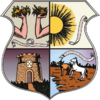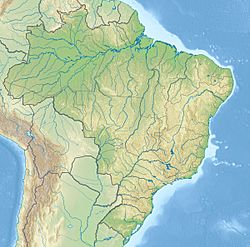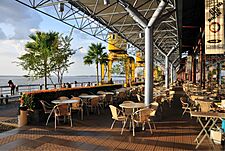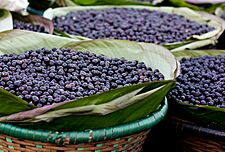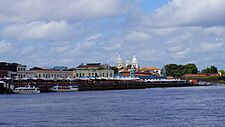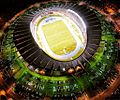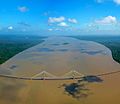Belém facts for kids
Quick facts for kids
Belém
|
|||
|---|---|---|---|
|
Municipality
|
|||
| Municipality of Belém | |||
|
Panoramic of the Republic Square in Downtown
Our Lady of Grace Cathedral
Siqueira Campos Square
Forte do Presépio
Ver-o-Peso Market
Peace Theater
View of the city from Guajará Bay
|
|||
|
|||
| Nicknames:
"City of Mango Trees", "Metropolis of Amazon".
|
|||
| Motto(s):
Os Estados do Norte estão conosco e nos seguem
(Northern states are with us and follow us) |
|||
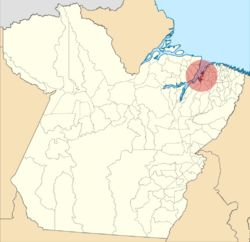
Location of Belém in the State of Pará
|
|||
| Country | |||
| Region | North | ||
| State | Pará | ||
| Founded | 12 January 1616 | ||
| Area | |||
| • Municipality | 1,059.40 km2 (409.04 sq mi) | ||
| Elevation | 10 m (30 ft) | ||
| Population
(12th 2022)
|
|||
| • Municipality | 1,303,403 | ||
| • Density | 1,322/km2 (3,420/sq mi) | ||
| • Metro | 2,249,405 | ||
| Demonym(s) | Belenense | ||
| GDP (PPP, constant 2015 values) | |||
| • Year | 2023 | ||
| • Total | $18.4 billion | ||
| • Per capita | $8,000 | ||
| Time zone | UTC-3 (BRT) | ||
| Postal code |
66000-001 to 66999-999
|
||
| Area code | +55 91 | ||
| HDI (2010) | 0.746 – high | ||
Belém is a big city in the north of Brazil. It is the capital and largest city of the state of Pará. Belém is often called the "gateway to the Amazon River" because it has a busy port and airport.
The city is about 100 km (62 miles) from the Atlantic Ocean. It sits on the Pará River, which is part of the huge Amazon River system. Belém is separated from the main Amazon delta by a large island called Ilha de Marajó (Marajo Island).
Belém has about 1.3 million people. If you count the nearby areas, the population is around 2.5 million. This makes it the 12th most populated city in Brazil. It is also the second largest city in the North Region, after Manaus.
The city was started in 1616 by the Kingdom of Portugal. It was the first European settlement in the Amazon region. Belém became part of Brazil in 1775. The newer parts of the city have modern buildings and tall skyscrapers. But the older, colonial areas still have charming squares filled with trees, old churches, and traditional blue tiles.
Belém is also known as the Metropolis of the Brazilian Amazon region. Another nickname is Cidade das Mangueiras, which means "City of Mango Trees". This is because there are so many mango trees there! People in Brazil often call it Belém do Pará to tell it apart from other towns named Belém.
The city has its own airport, Belém International Airport. This airport connects Belém to other cities in Brazil, South America, North America (United States), and Europe (Lisbon). Belém is also home to important universities like the Federal University of Pará.
Contents
What's in a Name?
Belém is the Portuguese name for Bethlehem. This name comes from Hebrew and means "the house of bread".
When the city was first founded, it was called "St. Mary of Bethlehem of Pará". Later, it was shortened to Belém do Pará. This name was chosen because Captain Francisco Caldeira Castelo Branco left to explore the lands of Pará on Christmas Day in 1615.
A Look at History
In 1615, a Portuguese captain named Francisco Caldeira Castelo Branco led a group to the Amazon. Their goal was to stop foreign traders (from France, Netherlands, and England) from going up the river.
On January 12, 1616, he landed in what is now Guajará Bay. He built a wooden fort there, which he called "Presépio" (meaning "nativity scene"). This fort is now known as "Forte do Castelo". The small settlement around the fort was named Feliz Lusitânia, meaning "Fortunate Lusitania". This was the very beginning of Belém.
The fort didn't stop all foreign trade, but it did prevent other countries from settling there. Feliz Lusitânia later changed its name to Nossa Senhora de Belém do Grão Pará. Belém officially became a city in 1655. It became the capital of Pará state in 1772.
In the early 1800s, there was some political trouble in the city. But things settled down by 1836.
For a long time, the sugar trade was very important in Belém. Then, cattle farming became popular. Later, growing rice, cotton, and coffee brought money to the city.
Belém became very important during the Amazon rubber boom. It was the main place for exporting rubber. Even after the rubber boom ended around 1912, Belém stayed a key business center for northern Brazil. It was like a main hub for goods coming from the Amazon valley.
City and Nature
Belém is located near several islands. Mosqueiro island has 14 freshwater beaches and is popular in summer. Caratateua is another nearby island.
There's also Tatuoca island, which has one of only seven special geophysical stations in the world. This station helps scientists study the Earth.
Climate of Belém
Belém has a tropical rainforest climate. This means it's hot and rainy all year round. There isn't a true dry season because it rains more than 60 mm every month. However, some months are wetter than others, usually from December to May.
The average temperature stays around 26.5 degrees Celsius throughout the year. Because Belém is in the Amazon, the natural plant life around the city is a tropical rainforest.
Belém's Economy
Belém is a major hub for exporting many valuable products from the Amazon. These include:
- aluminium
- iron ore and other metals
- nuts (especially Brazil nuts)
- pineapples
- cassava
- wood veneers
- hardwoods
After the 1930s, Japanese immigrants helped develop the growing of jute and black pepper near Belém. Marajó Island, which is the largest river island in the world, is just across the Rio Pará from Belém. Some livestock are raised there.
The city gets its electricity from the huge Tucuruí Dam. This dam is about 300 km southwest of Belém on the Tocantins River.
People of Belém
In 2018, the Metropolitan Region of Belém had about 2.5 million people. This area includes Belém and six other nearby cities.
In Belém itself, the population density was about 1337 people per square kilometer in 2012. Most people in Belém are of mixed heritage (61.8%). About 26.3% are White, and 11.5% are Black. There are also smaller groups of Asian and Indigenous people.
A study in 2011 showed that the people of Belém have a mix of European (68.6%), Amerindian (20.9%), and African (10.6%) ancestors.
Learning in Belém
Portuguese is the main language taught in schools in Brazil. In high school, students also learn English and Spanish.
Universities and Schools
Belém has many important educational places:
- Universidade Federal do Pará (UFPA)
- Universidade do Estado do Pará (UEPA)
- Federal Rural University of Amazonia (UFRA)
- Universidade da Amazônia (UNAMA)
- Centro de Instrução Almirante Brás de Aguiar (CIABA)
- Centro Universitário do Estado do Pará (Cesupa)
- Amazon Valley Academy International School (AVA)
- Escola Superior da Amazônia (UNIESAMAZ)
- Centro Universitário Metropolitano da Amazônia (UNIFAMAZ)
- Instituto Federal de Educação, Ciência e Tecnologia do Pará (IFPA)
Belém's Culture
Círio de Nazaré: A Big Celebration
On the second Sunday in October, Belém celebrates the Círio de Nazaré. This is the biggest religious event in Brazil!
The tradition started when a farmer named Plácido José de Souza found a statue of the Virgin Mary and baby Jesus by a creek. He took it home, but the statue kept going back to where he found it. People thought this was a miracle. So, Plácido built a small chapel there. Many people came to see the statue and honor it.
Now, the Círio is a huge procession that lasts about five hours. Thousands of people follow the statue through the streets of Belém. It's like the "Christmas of the Amazon" because everyone gets involved.
Before the main procession, there are smaller events. On the Saturday morning before the Círio, the statue is taken to a nearby city, Ananindeua. From there, it goes on a "Road Pilgrimage" to the Icoaraci pier for a special Mass.
Then, a "river pilgrimage" begins. This honors the "water men" who see the Virgin Mary as their protector. Many boats follow the Navy Corvette carrying the statue across Guajará Bay to Belém's pier. From there, it goes to the Gentil Bittencourt School.
The next procession is a candle-lit one. It tells the story of how the statue was found and returned to its special place. People follow a carriage with a huge rope, which is pulled by many faithful followers, until it reaches the Cathedral.
During the procession, there are amazing fireworks shows. Early the next morning, people gather at the Old City. At 7 o'clock, the archbishop places the statue on the carriage, and bells ring and fireworks go off. The main procession then goes through the city to the Nazareth Sanctuary Square. When it arrives, the statue is lifted so everyone can be blessed.
The celebrations last for 15 days! There's even a Children's Círio. The "Re-Círio" marks the end of the festivities, with a shorter journey back to the Gentil Bittencourt chapel.
Hangar Convention Center
The Hangar Convention and Fair Center of the Amazon is a huge place for events. It has 12 rooms, a food court, and parking for 800 cars. It's one of the most modern event spaces in Brazil.
With Hangar, Belém can host big national conventions. Before, these events usually didn't happen in the Northern region of Brazil. The main auditorium can hold 2,160 people. This center helps Belém attract more tourism.
Belém's Buildings
Belém's colonial architecture shows the style of 17th-century Lisbon in Portugal. Many buildings have beautiful tile-covered fronts. You can also see Neoclassical architecture in buildings like the Theatro da Paz, built in 1874. Many buildings from the late 1800s and early 1900s also look like French architecture.
Delicious Food
Belém's food uses local ingredients from the Amazon. One special fruit is "Cupuaçu". It comes from the Cupuaçu tree and has a unique smell and sour taste. People use its pulp to make juices, candies, jellies, and ice cream.
Açaí is another famous local food. It comes from a palm tree and has purple fruits with an earthy and fruity taste. It has been a favorite of local people for a long time and is now popular all over Brazil.
Because of its unique food, Belém joined the UNESCO Creative Cities Network for gastronomy in 2015.
World Social Forum
The World Social Forum is a big meeting where people discuss global issues. In 2009, it took place in Belém from January 27 to February 1.
Sports in Belém
Belém is home to three main football (soccer) teams in Pará:
Paysandu plays at the Estádio da Curuzú, which is the oldest stadium in Pará. Remo plays at the Baenão. Tuna Luso-Brasileira plays at the smaller Estádio Francisco Vasques.
The biggest stadium in the city is the Estádio Olímpico do Pará. It can hold 45,000 people. This stadium hosts big matches and events like the Grande Premio Brasil de Atletismo.
Places to Visit
Belém is a modern city with many tree-lined streets, public gardens, and interesting buildings. It's a leading center for education and culture in northern Brazil.
The city has a large cathedral called Igreja da Sé, founded in 1917. Santo Alexandre, built in 1616, is Belém's oldest church. Other important places include the Museu Paraense Emílio Goeldi (a museum) and the Teatro da Paz (a classical theatre).
The Ver-o-Peso market in the old port area is a very popular place for tourists. Belém also has a large football stadium, the Estádio Olímpico do Pará.
Utinga State Park
The Utinga State Park was created in 1993 to protect the city's water supply. It's a great place for people to enjoy nature, just a few kilometers from the city center.
The park has eight trails where you can see different plants and animals. The "monkey trail" is popular and takes about 40 minutes. Visitors can also learn about the water treatment plant that provides water to Belém.
Amazon Biopark Zoo
The Amazon Biopark Zoo is less than 15 km (9 mi) from Belém's center. It's surrounded by forests, rivers, and streams, showing off the Amazon's beautiful nature.
The zoo has about 14 mi (23 km) of trails. It is home to many animals, including four different types of alligators, monkeys, anteaters, otters, and colorful birds like macaws and toucans. There's also a museum with a collection of shells and mollusks.
Rodrigues Alves Wood–Botanical Garden
Inspired by the Bois de Boulogne Park in Paris, the Rodrigues Alves Wood is like a small piece of the Amazon rainforest right in the city. It covers 16 hectares and has 2,500 native plant species. You can find an orchid garden, lakes, caves, waterfalls, and even a small mountain replica. You might see small animals like squirrel monkeys, agoutis, and macaws there.
The Estação das Docas Complex
The Estação das Docas Complex is a renovated area of old port warehouses. These buildings were made from metal structures from England in the early 1900s.
This area is now a modern space with coffee shops, restaurants, stores, and travel agencies. It also has an auditorium and two memorials. There's a river station and a large outdoor area to enjoy.
Ver-o-Peso Market
The Ver-o-Peso Market started in 1688. It's a lively mix of colors, smells, and items. You can find medicinal herbs, many local fruits, arts and crafts, household items, meats, fish, and spices. The market has about two thousand stalls and traders. It's located near the old Iron Market by the quays.
Mosqueiro Island
Mosqueiro is a river island about 67 km (42 mi) north of Belém. It's a popular spot for beach tourists during the drier season.
Getting Around Belém
Airports
Belém International Airport is the main airport for the city. Its design lets natural light fill the large terminal.
The airport serves about 2.7 million passengers each year. It helps bring tourists to the Amazon and sends products out. The passenger terminal is fully air-conditioned and has a modern design. It also has special services for people with disabilities. Inside, you'll find plants from the Amazon and a fountain that sounds like rain.
There used to be a smaller airport called Brig. Protásio de Oliveira Airport (Júlio César). It was used for smaller planes but closed in 2022. Its functions moved to the main Belém Airport. The area of the old airport will become a park.
Belém Air Force Base – ALA9 is also located in Belém. It is one of the most important bases for the Brazilian Air Force.
Roads
BR-316 is the main highway for people coming from Northeastern Brazil. For visitors from the Southern, Southeastern, and Mid-Eastern Regions, the best route is BR-010. This highway starts in Brasília. PA-150 also connects Belém to Southern Pará.
Waterways
You can reach Belém by the Tocantins River and Amazonas River. It can also be reached from the Atlantic Ocean.
Railways
The EF-151 railway, also known as "Ferrovia Norte-Sul" (North-South Railway), is being extended. It will run to the city of Barcarena, which is about 111 km away. Once finished, Barcarena will be connected to important cities like Imperatriz and Anápolis.
Distances to Other Cities
- São Paulo: 2933 km
- Rio de Janeiro: 3250 km
- Brasília: 2132 km
- Manaus: 1489 km
- Teresina: 923 km
- São Luís: 806 km
- Santarém, Pará: 807 km
- Rio Branco: 2135 km
- Florianópolis: 3577 km
- Cuiabá: 2970 km
- Belo Horizonte: 2824 km
Famous People from Belém
- Hélio Gracie – martial artist
- Guilherme Paraense — Olympic medalist
- Rogério Ferreira – beach volleyball player, World Champion
- Myke Carvalho — Brazilian boxer
- Marcos Gueiros — Brazilian racing driver
- Beto Gonçalves — footballer
- Dira Paes — actress
- Fafá de Belém — singer
- Yago Pikachu — Brazilian football player
- Giovanni Silva de Oliveira – footballer
- Giuseppe Antonio Landi — architect
- Ismael Nery — painter
- Charles Guerreiro — Brazilian football player
- João Clemente Baena Soares — diplomat
- Larissa Pacheco — mixed martial artist
- Lyoto Machida — mixed martial artist
- Paulo Henrique Chagas de Lima — footballer
- Priscilla Meirelles — beauty queen
- Paulo Vítor — Brazilian football player
- Carlos Gracie — Brazilian martial artist
- Waldemar Henrique — composer
- Rosamaria Murtinho — actress
- Rossevelt Bala — heavy metal singer
- Victória Pitts – mezzo-soprano
Images for kids
-
Vitória Régia in Paraense Emílio Goeldi Museum
-
Almir Gabriel bridge over Guamá River and Amazon Rainforest.
-
Hélio Gracie, one of the founders of Brazilian jiu-jitsu.
See also
 In Spanish: Belém (Brasil) para niños
In Spanish: Belém (Brasil) para niños










